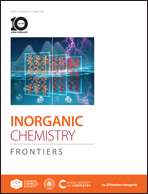Preparation of inorganic-framework molecularly imprinted TiO2/SiO2 nanofibers by one-step electrospinning and their highly selective photodegradation†
Abstract
To effectively treat pollution and overcome the lack of selectivity of TiO2-based photocatalysts, a 1D structure and molecular imprinting technology have been combined to produce TiO2/SiO2 hybrid fibers by a simple electrospinning method by directly adding templates into the precursor solution. In our design, TBOT acts as a titanium source and a functional monomer to combine with RhB and generate specific recognition sites, and SiO2 plays a role in inhibiting phase transition. The calcination process can not only remove the template and form an imprinting cavity but also enhance the crystallinity of photocatalysts. The inorganic framework also overcomes the shortcomings of the instability of traditional organic molecularly imprinted layers. In contrast to a nonimprinted sample, imprinted fibers exhibit higher adsorption capacity and selectivity, attributed to the specific combination through hydrogen bonds and space matching effect. The photocatalytic efficiency of the imprinted sample reached 100% within only 15 min, showing excellent photocatalytic performance and high selectivity. This work not only provides a novel, simple method to fabricate TiO2 fiber photocatalysts with high selectivity for the first time but also offers new strategies for the effective and selective treatment of pollutants in wastewater.

- This article is part of the themed collection: 2023 Inorganic Chemistry Frontiers HOT articles


 Please wait while we load your content...
Please wait while we load your content...